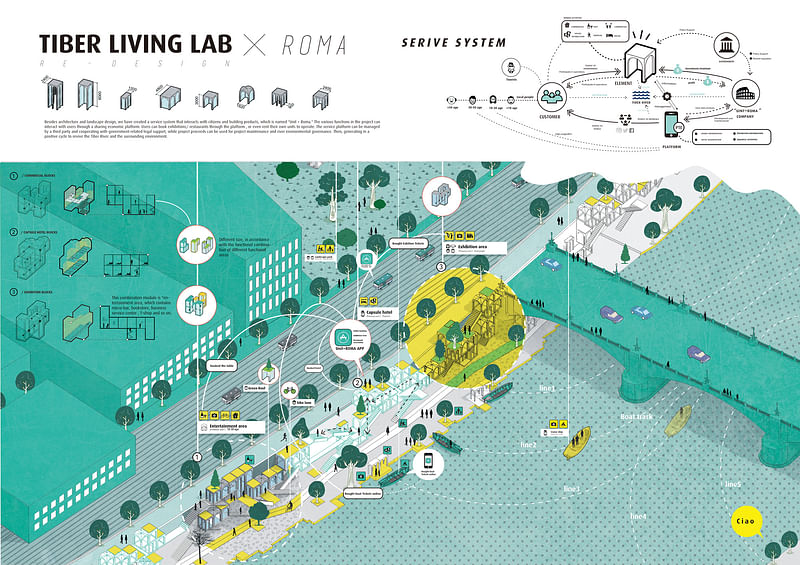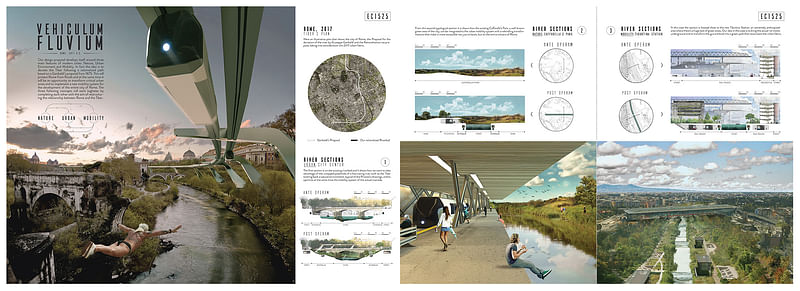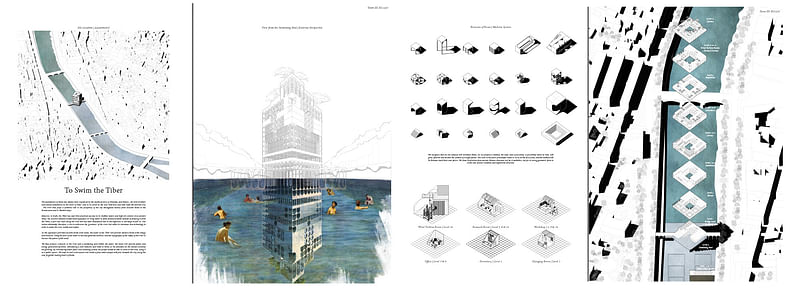Resurrecting Rome's River Tiber: Eleven's Rome 2017 Competition announces winners
By Mackenzie Goldberg|
Wednesday, Jul 12, 2017

Related
Legend has it that the Italian capital, Rome, was established along the banks of the Tiber river. In Roman mythology, the city's mythical founders, Romulus and Remus were sentenced to death by the King as children by way of being thrown into the river; however, a pitying servant placed the young twins in a basket and the God Tibernus ruled over the watercourse to ensure their safety. Their basket eventually got strategically caught in the roots of a fig tree, where they were rescued and raised by a female wolf and went on to build the Eternal City.
The Tiber river stretches 250 miles long and is the second longest river in Italy, flowing from the Apennines through Rome and into the Tyrrhenian Sea. Unfortunately today, the river's condition does not live up to its fabled status; the riverfront walkways are covered with graffiti of questionable artistic merit; Litter, overgrown vegetation, and improvised homeless encampments along its banks make a river-side stroll far from picturesque; and the water itself is so filthy that tourist cruises have even been suspended at times due to the pollution.
Now in its fifth run, Eleven's 2017 Rome Competition sought to address these issues. Architects, designers and thinkers from around the world were asked to reimagine the city through its waters and were challenged to design a 21st century river renaissance for Rome that could be a catalyst for change. In total, more than 130 teams submitted proposals for the waterway, out of which 9 have been selected as winners or honorable mentions. Take a look below at the tope entries, as voted by the jury and online community.


Winner: Tiber Living Lab
by Shengyu Huang, Chen Mengtong, Wu Wenhao and Wei Lifeng (China)
"Modular spaces are created through pod-like stackable structures which reference the arch – a quintessential Roman invention – as it’s defining aesthetic. And just like the arch archetype changed the world of engineering and architecture forever, this winning proposal wishes to change the way Rome engages with its iconic river by injecting life into its currently desolate edges. ‘Tiber Living Lab’ adds vibrancy to the area through the use of mixed-use facilities, amenities controlled by techy-apps, a new infrastructure of transport, and a financial strategy designed to benefit both tourist and resident. All this is packaged into an attractive presentation."

RELATED NEWS Rome 2017 - Call for Entry

Runner-Up: Acqua Roma
by Melissa Shin (USA)
"If you can’t bring the Romans to the river, then bring the river to the Romans! Acqua Roma imagines Rome in the year 2062, as a city where ancient treasures come to life in renewed, water-based activities for the people to immerse themselves in. Drawing from Pirenesi’s 1762 Campo Marzio plan as its inspiration, three hundred years on the Tiber is allowed to spread through the city; resurrecting long-lost traditions in the form of bathhouses, natatoriums, and water stages which once were synonymous to Rome at a time when the city represented the pinnacle of society, innovation and civic excellence. Acqua Roma seeks to imagine a future Rome, where the addition of a fluid urban layer serves as a catalyst for the city to reinvent itself."

People's Choice Award: Refounding Tiber
by Abdur Raoof Khan, Saman Imran, Fatima Urooj and Devesh Mani Tripathi (India)
"This project was voted by the general public online. The design proposes a new bridge for Rome with the intention of also bridging the past and future. The design takes inspiration from the Tiber legend of Romolo and Remo, the founders of Rome who were spawned by the very river. The bridge incorporates a bath complex to allow Romans and tourists to enjoy the waters of the river. The idea, in turn, is a nod to the ancient Roman bathhouses: an important element of socialization for citizens of all classes, wealth and status."

Honorable Mention: Elevating the Riverfront
by Vonn Weisenberger and Julia Brooks (USA)
"Rome’s relationship to the Tiber is physically reestablished by elevating the river edge. The sunken walkways which coast the river are rendered more accessible by lifting them on par with the urban level. These are made attractive by the use of flowerbeds, reeds and trees. But what makes this entry so captivating is the way in which water is turned into the main design protagonist through the creation of a wall of waterfalls, designed to shield the high river walls, purify the river and mask pedestrians from the frantic Lungotevere traffic noise. This creates a beautiful illusion which not only serves a function but adds to the romance of Rome’s river without overshadowing its unique views."
RELATED COMPETITION ROME 2017: 21st Century River Renaissance

Honorable Mention: Vehiculum Fluvium
by Sergio Bianchi, Simone Fracasso and Simone Russo (Italy)
"This impressive proposal is a reinterpretation of Garibaldi’s ideas for the Tevere recontextualised to suit the contemporary and future needs of the city. An artificial river is created, allowing for the Tevere’s tidal waters to be redirected and thus saving the city from future violent floods. Amenities such as green wedges, green transport and new buildings are imagined to sit on the banks of the new river branch. Meanwhile, the old river gets given back to both man and nature through the creation of a soft verge turned park and the tunneling of current primary traffic arteries. A new form of transport is introduced through the engineering of a monorail system, designed to make the city more accessible."

Honorable Mention: Procession of Arches
by Charlotte Loustalot and Roman Joliy (France)
"This beautifully rendered concept delivers a strong proposal through the use of poetry defined by minimal architectural rhythm. Poetic places are created from the existing anonymous river’s edge by the introduction of reinterpreted arches which are allowed to age with time. The arches become the mechanism of visually and spatially breaking down the soul-less walls of the river by introducing a human scale to them. This allows for intimate moments to be captured between them, and for the water-level to become a beautiful element of the city in its own right."

Honorable Mention: Tiber Two
by Jacqui Stacey and Cameron Stevenson (Australia)
"There is a discontinuity between the urban city level and the river’s edge, rendered worse by the imposing flood walls which line the Tiber. ‘Tiber Two’ wishes to comment on this discontinuity by creating a new space for the city to enjoy. The result is an aquatic piazza on the river that unites the city through water, whilst simultaneously showing the discontinuity of levels between river and city. Two functions unite in this design: an element of relaxation and pleasure in the piazza and an active element of ‘flow’ elevated above it, designed to allow the river to continue its journey to the sea."

Honorable Mention: To Swim the Tiber
by Andrew Kwok and David Majoe (UK)
"Water – we have seen – was a very important element for Rome throughout the centuries. Perhaps the best example of this can be found in the ancient Roman concept of public bath houses. These institutions served a very important function, not only as hygienic hubs but as pivotal social fulcrums where people of all classes interacted and engaged. ‘To Swim the Tiber’ reintroduced this concept, by creating a contemporary bath house in the Tiber River to act as a catalyst for interaction, river production and water purifier. The concept is generated through a combination of modules which link to another ancient Roman engineering stroke of genius: the arch."

Honorable Mention: Isole Dell'Anima
by Lena Wimmer, Basel Hamad, Sebastian Gubernatis and Iris Huneau (Germany)
"‘Isole dell’Anima’ (translated as ‘the islands of the soul’) imagines a new role for the river through the creation of artificial island in the Tiber. Instead of interacting with the surrounding, the design team decided to work directly on the water, and let the rest of the city discover the intervention. The islands create a peaceful place where someone can isolate themselves in nature at the heart of the bustling city: a fluvial park or, perhaps most fitting, what we can only describe as an urban-water-oasis-cluster. It’s an elegant solution to an ugly condition. One which does not wish to overpower the city by imposing itself upon it, but rather create a new dimension at the heart of the urban fabric. Through a handy app, the islands can be accessed by self-driving water-taxis, allowing the Tiber to also double up as a new artery for the movement of its population."

Share
0 Comments
Comment as :